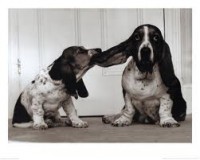Otitis……’ere what did you say?
Dogs and cats have extremely sensitive ears both to noise and physical stimuli owing to the fact that their pinnae are so much larger by ratio to the human. This, combined with the fact that hearing in these animals is a primary sense next to that of smell, highlights the importance of maintaining optimal aural health in our companions.
Hearing is a sense that has been valued and preserved in dogs since our co-evolution over thousands of years. Over recent years however, this attribute has been less highly regarded in dogs and generally underutilized. In contrast to days of old when dogs were rewarded for alerting humans to impending danger, they are now more often chastised for being noisy and persistent in their alarm attempts. Proper training and a sense of reward can assist dogs to adapt to the fact that we may need this service less than we used to long ago but it is still genetically encoded in most dogs.
Since dogs have been living in human families throughout our history and have been by our side during the rapid societal changes that we have all endured, the surviving breeds have adapted to modern life. Like children in verbally abusive environments they have also learned to not listen. This is directly against their genetic priming. Like children who develop otitis media as a response to the stress of not wanting to listen, it is possible that the canine ‘children’ adopt similar defence mechanisms.
Using the human parallel again, it is well acknowledged that children suffer eustachan tube underdevelopment and catarrhal otitis media, necessitating the trend to gromit surgery in chidren of recent years….the ‘tonsilectomy’ of the 90’s. Looking at this holistically, it is also possible that brachycephalic dog breeds that are being selected for larger heads and shorter necks and snouts could suffer the same physiological pressure on their ear canals as do newborn humans. I have fewer behavioural problem barking cases in my practice relating to an underutilized guarding instinct in brachycephalics, for example, that I do in normocephalic working dog breeds. Brachy dogs may have adapted already to largely ‘switching off’ that canine acuteness of hearing.
Apart from all of this is the rise in recent times of otitis externa cases in dogs and much less in cats. Although this is a disease of the ear canal and pinna it is primarily a skin disease. Approaching this holistically, the skin is an outlet for all disease in the body. The changes that occur in the skin and coat of cats and dogs reflect the underlying health status of the animal. Irrespective of where the primary disease symptoms occur they are expressed in the skin unless they are suppressed or treated appropriately. This is a primary reason why holistic vets do not recommend suppressing the expression of disease through the skin but rather seek to support the animal to enhance its ability to cure itself through enhancing immune mechanisms amongst other things. All symptoms are an attempt to cure and when we suppress these, cure becomes much more difficult to attain.
Recently I have also noticed that dogs or cats with dental disease and underlying infection in the ear/nose/throat, will have persistent itchy ears and this is not surprising. It is likely that inflammation in the head from any cause will create a cascade or flow on effect to other organs in the vicinity so I advise that animals with persistent ear problems have their teeth thoroughly examined by a veterinary dentist especially if there is gingivitis or tartar buildup.
Understanding the reason for disease symptoms helps to address an appropriate treatment plan and unfortunately there have been some tendencies such as the ones to which I have already alluded, that predispose certain breeds to particular problems. Holistic vets have always been able to see deeper reasons for disease but until recently have had difficulty proving or demonstrating this past their own successful practice experiences. I am very excited about the latest trend towards the study and ensuing research in epigenetics in animals and the role that nutrition and environment play in activating genes in certain individuals. I am compiling a list of diseases that I see in practice and the epigenetic triggers I believe could be investigated in the future. In the meantime I am content to continue to further pursue and broaden my knowledge through private practice experience.
What is normal?
One of the difficulties in helping animals to cure is the perception of normality.
Wax is normal. Dirt in the wax is normal. Normal, healthy ears are largely self maintaining, do not require routine cleaning and only need washing when they are struggling to cope with an overload of discharge or debris as part of a treatment plan. Checking them routinely is a good practice but removing the wax on a regular basis predisposes to further problems.
Like humans, a normal baby animal smells sweet and beautiful even if you don’t especially like them or the smell. It is an inoffensive smell that changes with maturity and the cascade of hormonal and dietary and behavioural changes that inevitably occur throughout their lives.
They do not need bathing to attain or maintain this smell unless they are unwell and this can be the first sign they may exhibit of being so. People who don’t like how they smell normally may perhaps seriously question whether they should live with a dog. Brushing and grooming assists a natural balance of oils and stimulation to the skin to continue to preserve good health. Overbathing removes or alters this innate balance of skin pH, commensal (good protective) bacteria and oils rendering the skin susceptible to attack from irritants and allergens. In contrast to this, a person who is aware that a change of smell or excessive shedding of hair may indicate a problem (not necessarily a bath!) will have a better chance of addressing an imbalance before it becomes an entrenched or intractable disease pattern.
An animal’s diet also needs to be carefully and thoroughly reconsidered, especially if symptoms of skin disease arise as an early warning that the animal is under duress.
To summarise this article;
Otitis externa is a skin disease
Suppressing symptoms will not cure the disease
Optimal treatment plans assist the body to heal itself with supportive care
Attempt to understand what is normal
Feeding an appropriate diet will minimize inflammation
Holistic (Integrative) Veterinary Medicine optimises treatment options.



May 18th, 2015 at 12:56 pm
Very complete and informative article, especially to identify when we should worry or not!